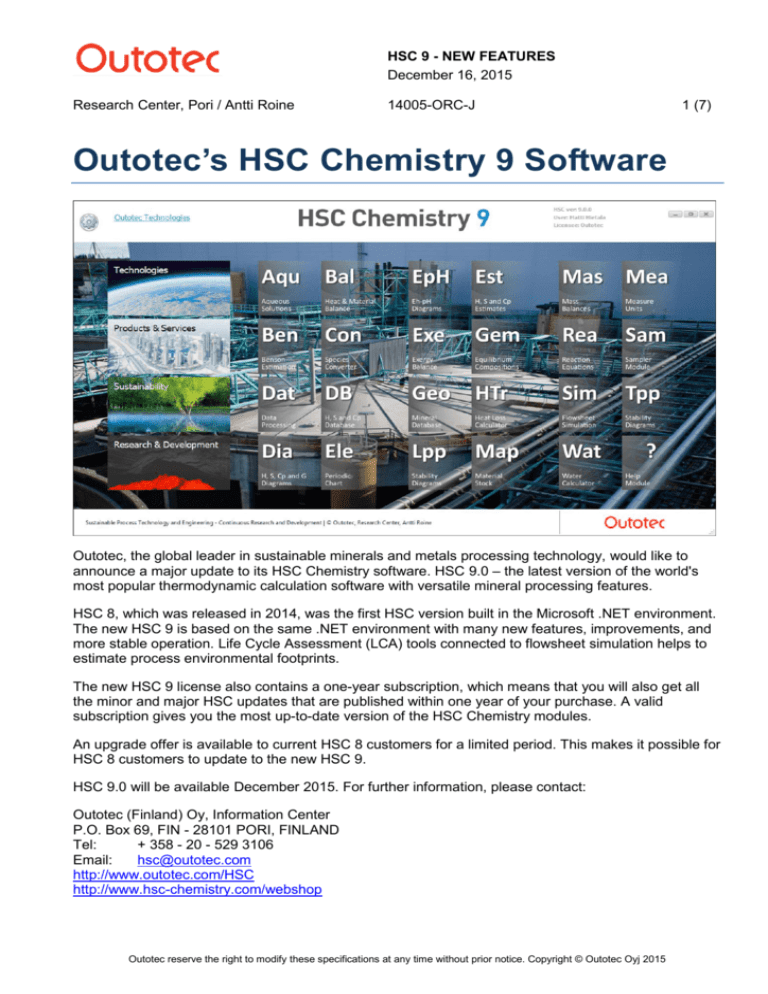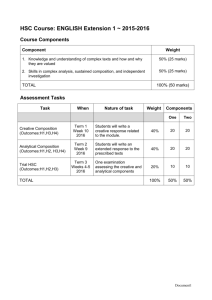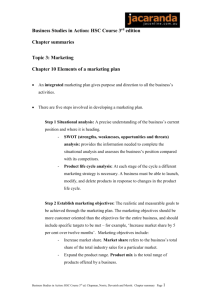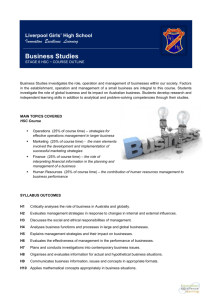Outotec's HSC Chemistry 9 Software
advertisement

HSC 9 - NEW FEATURES December 16, 2015 Research Center, Pori / Antti Roine 14005-ORC-J 1 (7) Outotec’s HSC Chemistry 9 Software Outotec, the global leader in sustainable minerals and metals processing technology, would like to announce a major update to its HSC Chemistry software. HSC 9.0 – the latest version of the world's most popular thermodynamic calculation software with versatile mineral processing features. HSC 8, which was released in 2014, was the first HSC version built in the Microsoft .NET environment. The new HSC 9 is based on the same .NET environment with many new features, improvements, and more stable operation. Life Cycle Assessment (LCA) tools connected to flowsheet simulation helps to estimate process environmental footprints. The new HSC 9 license also contains a one-year subscription, which means that you will also get all the minor and major HSC updates that are published within one year of your purchase. A valid subscription gives you the most up-to-date version of the HSC Chemistry modules. An upgrade offer is available to current HSC 8 customers for a limited period. This makes it possible for HSC 8 customers to update to the new HSC 9. HSC 9.0 will be available December 2015. For further information, please contact: Outotec (Finland) Oy, Information Center P.O. Box 69, FIN - 28101 PORI, FINLAND Tel: + 358 - 20 - 529 3106 Email: hsc@outotec.com http://www.outotec.com/HSC http://www.hsc-chemistry.com/webshop Outotec reserve the right to modify these specifications at any time without prior notice. Copyright © Outotec Oyj 2015 HSC 9 - NEW FEATURES December 16, 2015 Research Center, Pori / Antti Roine 14005-ORC-J 2 (7) HSC 9.0 New Features HSC Changes Theory into Reality Summary HSC 9 is based on the same Microsoft .NET environment as HSC 8. However, HSC 9 contains many new features, new modules, and several improvements to the old modules. These new features will be released gradually within the HSC 9 maintenance releases that become available with an HSC 9 subscription. HSC Subscription The new HSC 9 license also contains a one-year subscription, which means that the customer will also receive all the minor and major HSC updates that are published within one year of the purchase. A valid subscription gives you the most up-to-date version of the HSC Chemistry modules. HSC license is perpetual, but valid subscription is needed to get the new updates. Subscription should be renewed before the earlier subscription expires. The current HSC 8 customers may update to the new HSC 9 by purchasing a subscription which is valid till end of 2016. Outotec reserve the right to modify these specifications at any time without prior notice. Copyright © Outotec Oyj 2015 HSC 9 - NEW FEATURES December 16, 2015 Research Center, Pori / Antti Roine 14005-ORC-J 3 (7) Windows 10 Compatibility The HSC 8 was developed, tested, and validated for Windows 7 and 8. The new HSC 9 is, of course, Windows 7 and 8 compatible, but it will also be tested and validated for the new Windows 10. New HSC License Types HSC 8 licenses were made for local device installations like laptops and workstations. The new HSC 9 will have more licensing options: HSC 9 – Basic License is good for personal laptops and workstations and other local Machines. HSC 9 - Floating License is good for personal laptops and workstations and other local machines, if only very few out of many users are using HSC simultaneously. Installation is made on the local devices. HSC 9 - Server License gives the flexibility of using HSC via remote connection by several end users. HSC updates are also easy to carry out, because installations are carried out on one server. However, a lot of calculation capacity and fast network access are needed if several end users are using HSC on the same server. The Server License will be released in Q1/2016. HSC 9 - Virtual Device License gives the flexibility of running HSC on a virtual device. This, for example, makes it possible to run HSC on an Apple machine if Boot Camp multi boot utility is not available. The Virtual Device License will be released in Q1/2016. Sim - Flowsheet Simulation Module The Sim module can be used to create flowsheet-based process models for many applications. For example, hydrometallurgical and pyrometallurgical flowsheets as well as minerals processing systems, also including physical separation units used in recycling. Sim is one of the most important HSC modules. Several improvements and new features will be available: Improved calculation engine Improved Model Fit routine (Q1/2016) Improved Stream Converter routine Generic DLL unit operation model templates and examples Dynamic simulation with time scale (Q1/2016) Improved Scenario Editor with Monte Carlo Simulation (Q2/2016) Reaction units with Equilibrium wizard (Q2/2016) Formula Navigator in Unit Editors (Q2/2016) Improved mineral liberation based simulations with graphs (Q2/2016) Various new unit models, e.g. for mineral grinding (Q2/2016) Outotec reserve the right to modify these specifications at any time without prior notice. Copyright © Outotec Oyj 2015 HSC 9 - NEW FEATURES December 16, 2015 Research Center, Pori / Antti Roine 14005-ORC-J 4 (7) New export features to environmental footprint (LCA) dialog (Q2/2016) User-drawn title tables Text formatting is easier in Sim 9 as a new dedicated toolbar is present for text formatting Flowsheet tables contain new features: saving tables, loading from saved templates, applying formatting to selected or all tables, more formatting options. Improved Stream Content viewer: All stream content can be viewed including mass balance and experimental data. Unit Content Viewer shows unit balances Improved Process Tree: Input and output streams can be distinguished easily from the process tree and item selection in a diagram highlights the respective node in the process tree and vice versa. Also, editors can be opened directly by double clicking the nodes on the process tree. The user can create a collage view of unit icons with the new Collage Tool. Gem - Equilibrium Module Gibbs equilibrium calculations offer a practical way to investigate and study the effect of raw materials and process variables on the products of a chemical reactor and systems to estimate recoveries, opportunities, and limits of sustainability. The Gibbs Energy Minimization (Gem) method is utilized in the calculations. Several improvements and new features have been added to the Gem module: Improved calculation engine Logarithmic steps for species amounts, temperature, and pressure Improved chart routine Improved user interface Improved titration calculations Reactor calculation (Q1/2016) Phase predominance diagrams (Q1/2016) Constrained calculations (Q3/2016) DB – HSC Database The HSC database contains thermochemical data for chemical species. Most of the HSC calculation modules utilize this data automatically. Numerous small improvements have been made and new species have been added to the HSC 9 database. These updates will be available in Q1/2016. Outotec reserve the right to modify these specifications at any time without prior notice. Copyright © Outotec Oyj 2015 HSC 9 - NEW FEATURES December 16, 2015 Research Center, Pori / Antti Roine 14005-ORC-J 5 (7) Est - Estimation Module The HSC Estimation module gives a rough estimate of the H, S, and Cp values for the chemical species and non-stoichiometric minerals that exist in the HSC database, and also for those that do not exist in the HSC database. The Estimation module also gives the oxidation states of the elements in any given chemical compound. The new H, S, and Cp estimation routine significantly improves estimation accuracy for many species types. Ben - Benson Estimation Module Benson estimation is an HSC module that estimates the H, S, and Cp data of organic chemical compounds and is also especially useful for estimating properties for complex mixed organic scrap, residues, etc. The number of organic compounds is obviously large and quite often the H, S, and Cp data are missing. A few new features have been added: Revised menu logic and unified visual look for addition of molecule structural elements. Added feature for reference species list filtering. More elements (Q3/2016) Geo – Mineral Database Module Geo is a collection of tools developed originally for geologists and mineralogists. However, these tools may also be useful for other professionals. HSC Geo offers an extensive database with data on 13,346 minerals. HSC 9 introduces some important new features: Improved and updated user interface (Q1/2016) Capability to import mineral liberation information from different Automated Mineralogy systems, now also including QemScan and IncaMineral (Q1/2016) Improved versatile processing and reporting of mineral liberation data (Q2/2016) Mass balancing of mineral liberation data (particle tracking) (Q4/2016) Outotec reserve the right to modify these specifications at any time without prior notice. Copyright © Outotec Oyj 2015 HSC 9 - NEW FEATURES December 16, 2015 Research Center, Pori / Antti Roine 14005-ORC-J 6 (7) Mas – Mass Balance Module The Mass Balance module uses complex data reconciliation techniques to convert incomplete experimental mineral process data to balanced data. This makes it possible to calibrate theoretical process models or simply to create consistent analyses for yield and efficiency estimates for complete energy and material flow systems. This module is connected to the Sim module. Improved calculation engine for large data matrices Wizard to assist through mass balancing tasks Automatic balance accuracy estimates (Q1/2016) Balancing of liquid soluble components (Q2/2016) More options to fix data, specify the sampling method, and measurement of standard deviation will be added to the Mass Balance module. New features will become available in Q2/2016. Fit – Model Fit Routine The HSC Sim Model Fit tool has been designed for use in conjunction with the HSC Mass Balance module. The Sim Model Fit tool enables the conversion of balanced experimental particle data into model parameters. The experimental data is organized and imported using Mass Balance’s step-by-step stages. The data is automatically saved with the flowsheet drawing. The Model Fit tool is capable of fitting several flotation recovery kinetic models, both for laboratory and plant scale data. Sim Model Fit supports several flotation layouts (laboratory/plant) and contains several built-in model equations. Several types of models can be fitted with: 1) A single repetition phase 2) Sequential flotation with one repetition stage 3) Open loop flotation with repetitions 4) Several stages and closed loop flotation Model fitting will be extended to the unit DLL model, which will make it possible to fit the parameters of any unit DLL. Several new features will be added to the Model Fit Routine: New graphs, e.g. for grade-recovery plotting (Q1/2016) Capability for sized flotation kinetics fitting (Q1/2016) Improved fitting of reverse flotation systems (Q2/2016) Fitting of the DLL unit model parameters for all simulation models (Q3/2016). Outotec reserve the right to modify these specifications at any time without prior notice. Copyright © Outotec Oyj 2015 HSC 9 - NEW FEATURES December 16, 2015 Research Center, Pori / Antti Roine 14005-ORC-J 7 (7) Nav – Diagram Navigator Diagram Navigator is a new module, which can be used to digitize scanned charts, diagrams, and x-y plots of functional data. Diagram Navigator is also a tool to simplify the viewing of x-y and x-y-z ternary diagrams. It provides the user with a simple way to get ternary coordinates of any point within the diagram. Navigator will be available in Q2/2016. Mat – Material Database Material Database is a new HSC module that can be used to save information on different materials into the same database, such as concentrates, fuels, sludges, steels, plastics, etc. which may be used, for example, as raw materials for HSC Sim process models. Material properties have been divided into three categories: info, properties, and compositions. General info contains material names, synonyms, REACH, EC number, etc. The default material properties are density, melting point, electrical conductivity, tensile strength, etc. The composition group also contains elemental and chemical species analysis fields. Dynamic properties are a very special feature of the HSC Material database, which means that users can add their own custom properties to the materials. The Material database has links to species, elements, and mineral databases. Material Database will be available in Q1/2016 and linked to HSC Sim in Q2/2016. Mix – Mixture Calculator Mixture Calculator can be used to create mixtures of the materials in the Material database. This makes it possible to create feed mixtures, for example, for an HSC Sim process model. Mixture Calculator will be available in Q2/2016. Other New Features Several other new features, improvements, and bug fixes will also be added within the HSC subscription period of Q1/2016 - Q4/2016. The development of HSC 8 version will not continue since the development focus will be on HSC 9. Outotec reserve the right to modify these specifications at any time without prior notice. Copyright © Outotec Oyj 2015







